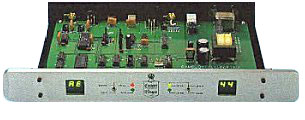| Columns Retired Columns & Blogs |
Camelot Technology Dragon Pro Jitter Reducer
 The Dragon Pro is, I believe, the most eagerly awaited of the Camelot products. Since the disappearance of Audio Alchemy's DTI•Pro 32, no comparable anti-jitter and resolution-enhancement product has come along to replace it. (Yes, there are simpler anti-jitter boxes, and there is the Genesis Digital Lens, but these are not truly comparable in approach.) Well, the Dragon is everything that the DTI•Pro 32 was, and more!
The Dragon Pro is, I believe, the most eagerly awaited of the Camelot products. Since the disappearance of Audio Alchemy's DTI•Pro 32, no comparable anti-jitter and resolution-enhancement product has come along to replace it. (Yes, there are simpler anti-jitter boxes, and there is the Genesis Digital Lens, but these are not truly comparable in approach.) Well, the Dragon is everything that the DTI•Pro 32 was, and more!
The Dragon Pro anti-jitter box offers both jitter reduction and resolution enhancement, along with I2S in/out. Considering the number of Web newsgroup ads from folks wanting to buy AA DTI•Pro 32s, this baby has a waiting market.
The Dragon Pro accepts coax S/PDIF, AES/EBU, TosLink, and AT&T glass inputs, as well as I2S. Its outputs are S/PDIF, AES/EBU, and I2S. If this ain't enough for you (and it ought to be), you have the option of a special hookup arrangement with Camelot's Uther DAC that I also review in this issue, the Royal Bloodline, which adds the Uther's inputs to this array (more about this below). Following a Crystal CS8412 input receiver, the Dragon Pro locks the 16-bit input signal with two phase-locked loops of different bandwidths. (Even the I2S input clock is subjected to this lock.) This is the primary jitter-reducer.
The Dragon Pro also provides a choice of apparent resolution enhancement, to 18 or 20 bits, by the addition of triangular dither. Finally, the subcode data on the incoming datastream, including the "U" bit (user bit), can be a source of jitter on the next leg of the trip to the DAC, and in general is of no particular use in audio. The Dragon Pro strips that bit from the datastream and affords yet another type of jitter reduction, effective even with DACs that accept only 16-bit input. (Remember those?) High-quality transformers are used on all the nonoptical inputs and the outputs.
The Dragon Pro's ergonomics are excellent. First, bright (almost too bright) alphanumeric displays indicate the selected input and the sampling rate, while LEDs indicate input lock, signal phase, and the bit depth of the output signal. Second, front-panel controls permit power on/off, input selection, phase reversal, and bit-depth selection. In addition, all this is done with only two toggle switches.
The chassis is, however, strangely smaller and different in shape from those of Camelot's Merlin I transport and Uther DAC. Late news from Camelot indicates that a Dragon Pro2 will have an extended 17" front-panel width, with sharper radiusing of the corners, and that newer Uthers will adopt the same profile. The other change that will distinguish the Pro2 will be the adoption of yet another proprietary I2S connector, a 6-pin in-line locking DIN for input and output in addition to the current circular 5-pin DINs. Will there ever be a universal standard? Watch Stereophile for breaking news and see the Sidebar for suitable cables.
About the Uther/Dragon symbiosis: Sure, you can connect them up as you would any anti-jitter box and DAC, with any of the variety of connectors available. However, by connecting them with the proprietary Royal Bloodline connection (4-pin modular telephone cord) and with a reciprocal pair of I2S cables, you can operate the two units as if they were one. For example, you can switch among all of the inputs of the Dragon and Uther and pipe them through all the functions. All of the inputs and all of the control modes (dither, phase, mute, volume, balance) can be accessed from the front panels or from the remote control that comes with the Uther. Setting up this interconnection is only a little hairy, but clear step-by-step instructions are provided. Besides, unless you have many digital sources and/or need to use the remote with the Dragon for A/B comparisons, the standard connection scheme works just fine.
Sound?
Need you ask? This is a better DTI (footnote 2). The improvements in subjective resolution and soundstage were such that I didn't want to remove it from the system once it was in. For details, I refer the reader to the Stereophile reviews of the DTI•Pro32, and to my review of the DDS•Pro (footnote 1). I cannot deny the Dragon Pro at least the same standing.
Putting the Dragon Pro into the Audio Alchmey system in place of the DTI didn't make much of a difference. On the other hand, popping the DTI into the Camelot system was marginally less successful. For example, I've been enjoying a CD by the North Texas Wind Symphony that contains an arrangement by Keith Wilson of Hindemith's Symphonic Metamorphoses on Themes by Carl Maria von Weber (Klavier KCD 11077). This is a delightful translation performed with wit and style, but the recording per se is a bit edgy, the brass somewhat harsh and spitty. With the DTI, I kept switching and/or moving speakers and fiddling with the gain, but achieved little satisfaction. With the Dragon Pro, I heard the problem clearly: a strange mix and overload on the brass. Now, knowing what is amiss, I can relax and enjoy the Hindemith for the wonderful performance it is.
Summary
The Dragon Pro should become the new standard for anti-jitter processing, and with the Uther 2.0 sounded great.
Footnote 1: Stereophile, Vol.19 Nos.3 & 7 and Vol.19 No.9, respectively.
Footnote 2: For the details of the review system, see my review of the Camelot Uther 2.0 elsewhere in this issue.
- Log in or register to post comments




































